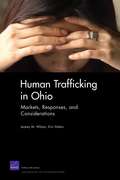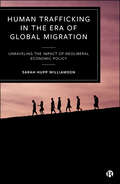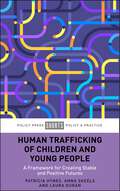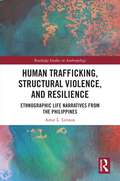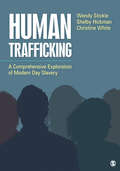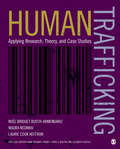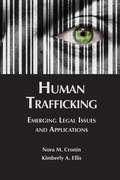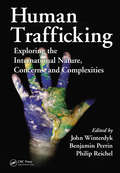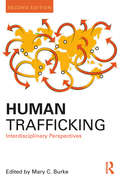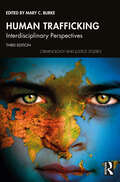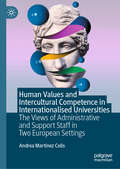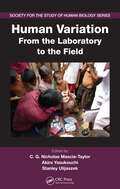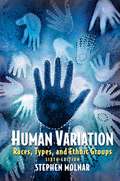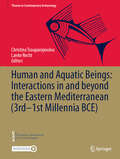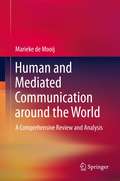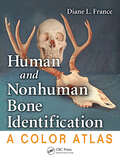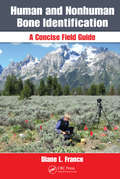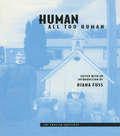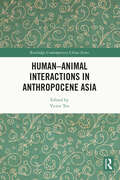- Table View
- List View
Human Trafficking in Conflict: Context, Causes and the Military (Crime Prevention and Security Management)
by Hayley Watson Julia Muraszkiewicz Toby FentonThis edited book examines the different forms of human trafficking that manifest in conflict and post-conflict settings and considers how the military may help to address or even facilitate it. It explores how conflict can facilitate human trafficking, how it can manifest through a variety of case studies, followed by a discussion of the reasons why the military should include a stronger consideration of human trafficking within their strategic planning given the multiple scenarios in which military forces come into contact with victims of human trafficking, and how this ought to be done. Human Trafficking in Conflict draws on the expertise of scholars and practitioners to develop the existing conversations and to offer multiple perspectives. It includes a discussion of existing frameworks and perspectives including legal and policy, and whether they are configured to address human trafficking in conflict.
Human Trafficking in Ohio
by Erin Dalton Jeremy M. WilsonWilson and Dalton explore the extent and characteristics of human trafficking in Ohio through both a content analysis of newspaper accounts and interviews with criminal justice officials and social service providers. The authors identify and discuss sex-trafficking cases in Toledo and forced-labor cases in Columbus, and compare the two cities' responses to human trafficking. They conclude with suggestions on how these responses might be improved.
Human Trafficking in the Era of Global Migration: Unraveling the Impact of Neoliberal Economic Policy
by Sarah Hupp WilliamsonFactors such as inequality, gender, globalization, corruption, and instability clearly matter in human trafficking. But does corruption work the same way in Cambodia as it does in Bolivia? Does instability need to be present alongside inequality to lead to human trafficking? How do issues of migration connect? Using migration, feminist, and criminological theory, this book asks how global economic policies contribute to the conditions which both drive migration and allow human trafficking to flourish, with specific focus on Cambodia, Bolivia, and The Gambia. Challenging existing thinking, the book concludes with an anti-trafficking framework which addresses the root causes of human trafficking.
Human Trafficking of Children and Young People: A Framework for Creating Stable and Positive Futures
by Patricia Hynes Anna Skeels Laura DuránHuman trafficking of children and young people is a major concern yet there is limited research on the lived experiences of those affected and even less on their post-trafficking aspirations, strengths and capabilities. This book argues that human trafficking and/or exploitation should be seen as child abuse rather than viewed through immigration or criminal justice lenses. It draws on new research from outcomes of two participatory studies with young people affected by human trafficking. The first study focuses on the development of a Creating Stable Futures Positive Outcomes Framework (CSF-POF), centred around children’s rights and based on the views of young people themselves. The second details how this framework was implemented for the first time with young people through an outcomes evaluation of the Independent Child Trafficking Guardianship (ICTG) service in England and Wales. An invaluable text, this book guides policy makers, practitioners, local authority professionals and voluntary sector organisations working to protect children and young people from human trafficking and helping them to move forwards positively following abuse.
Human Trafficking, Structural Violence, and Resilience: Ethnographic Life Narratives from the Philippines (Routledge Studies in Anthropology)
by Amie L. LennoxThis book explores and examines human trafficking in Eastern Mindanao in the Philippines, and the social conditions which facilitate and maintain this exploitation. Through a combination of ethnographic research and life-narrative interviews, the book tells the stories of those who have experienced exploitation, and analyses the social conditions which form the context for these experiences. This book places the trafficking of migrants in context of the local social setting where migration, including human trafficking of migrants, is one of the limited options available for work. It explores how these social configurations contribute to exploitation both domestically and internationally. This book also draws on first-person accounts from those who have experienced trafficking or exploitation, offering lived experiences which reveal deep and complex cultural, social, and personal expressions of meaning, resilience, and hope within constrained, unequal, and even violent circumstances. This book will appeal to students and scholars researching and studying in the fields of social and cultural anthropology and Southeast Asian studies.
Human Trafficking: A Comprehensive Exploration of Modern Day Slavery
by Christine A. White Wendy Stickle Shelby Nichole HickmanHuman Trafficking: A Comprehensive Exploration into Modern Day Slavery examines the legal, socio-cultural, historical, and political aspects of human trafficking and modern-day slavery. While most texts only cover sex trafficking and labor trafficking, this text takes a more inclusive approach, provide coverage of what is currently known about organ trafficking, child marriage, and child soldiers as well. These topics are explored within the borders of the United States as well as across the world. The reality is that this problem is not limited to one country or, even, one continent. Technology and globalization have made this an international crisis that requires a collaborative and cooperative international response. The goal of this text is to provide an accurate understanding of all forms of human trafficking and current responses to this crime.
Human Trafficking: A Comprehensive Exploration of Modern Day Slavery
by Christine A. White Wendy Stickle Shelby Nichole HickmanHuman Trafficking: A Comprehensive Exploration into Modern Day Slavery examines the legal, socio-cultural, historical, and political aspects of human trafficking and modern-day slavery. While most texts only cover sex trafficking and labor trafficking, this text takes a more inclusive approach, provide coverage of what is currently known about organ trafficking, child marriage, and child soldiers as well. These topics are explored within the borders of the United States as well as across the world. The reality is that this problem is not limited to one country or, even, one continent. Technology and globalization have made this an international crisis that requires a collaborative and cooperative international response. The goal of this text is to provide an accurate understanding of all forms of human trafficking and current responses to this crime.
Human Trafficking: Applying Research, Theory, and Case Studies
by Noel B. Busch-Armendariz Laurie C. Heffron Maura B. NsonwuThis practical, interdisciplinary text draws from empirically grounded scholarship, survivor-centered practices, and an ecological perspective to help readers develop an understanding of the meaning and scope of human trafficking. Throughout the book, the authors address the specific vulnerabilities of human trafficking victims, their medical-psycho-social needs, and issues related to direct service delivery. They also address the identification of human trafficking crimes, traffickers, and the impact of this crime on the global economy. Using detailed case studies to illuminate real situations, the book covers national and international anti-trafficking policies, prevention and intervention strategies, promising practices to combat human trafficking, responses of law enforcement and service providers, organizational challenges, and the cost of trafficking to human wellbeing.
Human Trafficking: Applying Research, Theory, and Case Studies
by Noel B. Busch-Armendariz Laurie C. Heffron Maura B. NsonwuThis practical, interdisciplinary text draws from empirically grounded scholarship, survivor-centered practices, and an ecological perspective to help readers develop an understanding of the meaning and scope of human trafficking. Throughout the book, the authors address the specific vulnerabilities of human trafficking victims, their medical-psycho-social needs, and issues related to direct service delivery. They also address the identification of human trafficking crimes, traffickers, and the impact of this crime on the global economy. Using detailed case studies to illuminate real situations, the book covers national and international anti-trafficking policies, prevention and intervention strategies, promising practices to combat human trafficking, responses of law enforcement and service providers, organizational challenges, and the cost of trafficking to human wellbeing.
Human Trafficking: Emerging Legal Issues and Applications
by Kimberly Ellis Nora Cronin Peter BlairHuman Trafficking: Emerging Legal Issues and Applications offers practical, tested, and cutting-edge approaches to addressing human trafficking and remediating its victims. It explores new digital technologies used to investigate the crime; tools for attorneys representing victims in criminal, labor, and immigration cases; and ways to help child victims of sex trafficking. This book proposes unique solutions to human trafficking in the United States, Australia, and Europe that can be applied elsewhere in the world. It explores the intersection of human trafficking with other phenomena such as cults, drug trafficking, human rights, and gender issues. Importantly, this book unveils the cutting-edge Social Influence Model for admitting evidence of undue influence and coercion into court when trafficking victims find themselves on the wrong side of a prosecution. Written for practitioners working in the courts and on the ground, Human Trafficking: Emerging Legal Issues and Applications is an essential tool for righting the wrongs of human trafficking.
Human Trafficking: Exploring the International Nature, Concerns, and Complexities
by Benjamin Perrin John Winterdyk Philip ReichelHuman trafficking is a crime that undermines fundamental human rights and a broader sense of global order. It is an atrocity that transcends borders with some regions known as exporters of trafficking victims and others recognized as destination countries. Edited by three global experts and composed of the work of an esteemed panel of contributors,
Human Trafficking: Interdisciplinary Perspectives
by Mary C. BurkeThe practice of one human being exploiting another in slavery-like conditions is not new. Today, it is called human trafficking. Social, political, and economic forces over the past 60 years have changed how and why this human rights abuse occurs. In order to solve this or any social problem, it is important that it is fully understood. With a range of contributing subject experts from different disciplines and professions, this text comprehensively explains human trafficking as it exists and is being addressed in the twenty-first century. Human Trafficking is essential reading for professionals working in many fields, including law enforcement, human services, and health care, and for concerned citizens interested in human rights and how to make a difference in their communities. This book is also intended for use in undergraduate and graduate interdisciplinary courses in human trafficking. A bank of test items applicable to each article in the book is available to instructors interested in selecting this edition for course use. Simply send an e.mail to the publisher at saleshss@taylorandfrancis.com
Human Trafficking: Interdisciplinary Perspectives (Criminology and Justice Studies)
by Mary C. BurkeWith a range of experts from different disciplines and professions, this text comprehensively explains human trafficking as it exists and is being addressed in the twenty-first century. The first section gives an overview of the issue and contextualizes it within a human rights and historical framework. The second section provides the reader with more detailed, interdisciplinary information about trafficking. The third section, which contains a chapter written by a former FBI agent, focuses on the anti-trafficking movement and addresses international responses to the problem, as well as considerations for working with victims. Human Trafficking closes with a chapter about how trafficking is being addressed and how individuals, larger social groups, and organizations can get involved in putting an end to the crime and to helping survivors. Human Trafficking is essential reading for professionals in law enforcement, human services, and health care, and for concerned citizens interested in human rights and making a difference in their communities. This book is also intended for use in undergraduate and graduate interdisciplinary courses in human trafficking.
Human Trafficking: Interdisciplinary Perspectives (Criminology and Justice Studies)
by Mary C. BurkeIn Human Trafficking: Interdisciplinary Perspectives experts from a wide range of disciplinary and professional backgrounds provide a uniquely comprehensive understanding of human trafficking in the twenty-first century. Chapter authors consider historical, sociocultural, legal, public health, human rights, and psychological aspects of this issue. New chapters address important topics such as racism, child soldiers, organ trafficking, and the role of technology and the banking industry in trafficking. The third edition also explores the ways in which institutionalized oppression of people of color, Native Americans, and those in the LGBTQ+ community can underlie vulnerability of these populations to being trafficked. Human Trafficking is essential reading for professionals in law enforcement, human services, and health care, and for concerned citizens interested in human rights and making a difference in their communities. This book is also intended for use in undergraduate and graduate interdisciplinary courses in human trafficking.
Human Trafficking: Perspectives from Nursing, Criminal Justice, and the Social Sciences
by Donna Sabella Mary De ChesnayThis book presents various forms of human trafficking, a growing trend in the exploitation of large numbers of people with concurrent public health, socio-cultural, and economic costs to countries burdened with the consequences of the COVID-19 pandemic. Edited by psychiatric-mental health nurses and an applied anthropologist, this volume covers all forms of human trafficking: sex trafficking, forced labor, forced marriage, baby trafficking, organ trafficking, child marriage, and child soldiers with a global public health and policy focus. As such, it fills a gap in human trafficking knowledge and is built on courses springing up around the United States in multiple disciplines. Medical, mental health, and social work interventions are included as well as information about programs with documented outcomes. Each chapter includes state of the art of knowledge with case studies illustrating specific focal ideas, discussion, questions and exercises in order to help readers retain and reinforce chapter material. This textbook will be useful in the disciplines of nursing, medicine, public health, social work, and policy making, as well as in disciplines in which human trafficking is a current interest, such as law, criminal justice, and education.
Human Values and Intercultural Competence in Internationalised Universities: The Views of Administrative and Support Staff in Two European Settings
by Andrea Martínez CelisThis book investigates the perceptions of the administrative and support staff at two universities (one in Spain, the other in the Netherlands) regarding internationalisation in their institutions and their own perceived intercultural competence within their contexts. Using the Schwartz value system, the author aims also to understand and explore how human values relate to attitudes and intercultural competence more broadly. The book argues for the importance of intercultural competence of administrative and support staff in internationalised universities, as well as their key role as essential agents in promoting internationalisation. The author proposes an interdisciplinary method to evaluate intercultural competence from an emic perspective—through questionnaires and interviews—and from an etic perspective—analysing participants’ discursive constructions to reveal their human values. This volume will be of interest to academics and practitioners in fields such as linguistics, intercultural competence, intercultural and cross-cultural studies, internationalisation of higher education, and sociology.This book investigates the perceptions of the administrative and support staff at two universities (one in Spain, the other in the Netherlands) regarding internationalisation in their institutions and their own perceived intercultural competence within their contexts. Using the Schwartz value system, the author aims also to understand and explore how human values relate to attitudes and intercultural competence more broadly. The book argues for the importance of intercultural competence of administrative and support staff in internationalised universities, as well as their key role as essential agents in promoting internationalisation. The author proposes an interdisciplinary method to evaluate intercultural competence from an emic perspective—through questionnaires and interviews—and from an etic perspective—analysing participants’ discursive constructions to reveal their human values. This volume will be of interest to academics and practitioners in fields such as linguistics, intercultural competence, intercultural and cross-cultural studies, internationalisation of higher education, and sociology.
Human Variation: From the Laboratory to the Field (Society for the Study of Human Biology)
by Stanley Ulijaszek C. G. Nicholas Mascie-Taylor Akira YasukouchiThe transition in anthropological and biomedical research methods over the past 50 years, from anthropometric and craniometric measurements to large-scale microarray genetic studies has resulted in continued revision of opinions and ideas relating to the factors and forces that drive human variation. Human Variation:From the Laboratory to the Field
Human Variation: Races, Types, and Ethnic Groups
by Stephen MolnarBasic text for the sophomore/junior level course in Human Variation or Human Diversity taught anthropology or biology departments.This classic introduction to human variation, has been thoroughly updated to include the issues and controversies facing the contemporary study of diversity.
Human and Aquatic Beings: Interactions in and beyond the Eastern Mediterranean (Themes in Contemporary Archaeology)
by Lærke Recht Christina TsouparopoulouThis volume examines the role of fish and molluscs in everyday life as well as in terms of their impact on social structures, and as part of ideological and symbolic expression. Given the prevalence of anddependence on water in various forms in all regions of the Eastern Mediterranean, Egypt and Western Asia, it is no wonder that fish and other aquatic species made an impact on human lives. Yet this topic remains rather understudied. Until recently, ongoing projects in marine and freshwater species and their interaction with humans and the environment either focus on the European marine ecosystem or on themes other than the social interactions of humans and aquatic species. The chapters in this volume explore questions related to fishing practices and technologies, social status, human-fish/mollusc relations (including potential over-exploitation), and fish/molluscs in ritual practices (e.g. as temple offerings, festival consumption, burial offerings), and ideology and religion (e.g. associated with supernatural beings or sacred space, as hybrid creatures, and as represented in luxury goods). The volume also examines aquatic species as a nonalimentary resource, for example as jewellery, inlays, dyeing and medicinal purposes. The material under investigation includes faunal remains (worked and unworked), fishing gear and related tools, iconography and written sources. Many chapters also integrate multiple lines of evidence, ranging from stylistic, contextual and iconographic analyses to zooarchaeological investigations. This volume is relevant to archaeologists, zooarchaeologists, biologists and anyone interested in human-animal relations and/or the archaeology of the early Eastern Mediterranean and surrounding regions.
Human and International Security in India (Routledge New Horizons in South Asian Studies)
by Crispin Bates Akio Tanabe Minoru MioWith its common colonial experience, an overarching cultural unity despite apparent diversities, and issues of nation-building cutting across national frontiers, South Asia offers a critical site on which to develop a discourse on regional security that centres on the notion of human security. This book analyses the progress that has been achieved since independence in multiple intersecting areas of human security development in India, the largest nation in South Asia, as well as considering the paradigms that might be brought to bear in future consideration and pursuance of these objectives. Providing original insights, the book analyses the idea of security based on specific human concerns cutting across state frontiers, such as socio-economic development, human rights, gender equity, environmental degradation, terrorism, democracy, and governance. It also discusses the realisation that human security and international security are inextricably inter-linked. The book gives an overview of Indian foreign policy, with particular focus on its relationship with China. It also looks at public health care in India, and issues of microfinance and gender. Democracy and violence in the country is discussed in-depth, as well as Muslim identity and community. Human and International Security in India will be of particular interest to researchers of contemporary South Asian History, South Asian Politics, Sociology and Development Studies.
Human and Mediated Communication around the World
by Marieke De MooijThis book is unique in the sense that it offers a comprehensive review and analysis of human communication and mediated communication around the world. This is one of the first attempts to do so in a systematic, comprehensive way. It challenges the assumption that Western theories of human communication and mass communication have universal applicability. It surveys the applicability of mass communication theories to other than Western cultures. The book explains the influence of culture on all forms of communication behavior, be it personal, mediated or mass communication. It presents communication theories from around the world, incorporating a vast body of literature from Europe, Asia, Africa and Latin America. This updated information on important international perspectives that includes both interpersonal and mediated communication is presently not readily available in other sources. The book offers an integrated approach to understanding the working of electronic means of communication that are hybrid media combining human and mediated communication. These new media that are often presented as universal are even more culture-bound than the traditional media.
Human and Nonhuman Bone Identification: A Color Atlas
by Diane L. FranceWhen a bone of unknown origin is found at a location, forensic implications arise immediately. Is this bone human, and if so, is it evidence of a murder? Human and Non-Human Bone Identification: A Color Atlas presents a comprehensive handbook of photographs and other information essential for law enforcement and forensic anthropologists when examin
Human and Nonhuman Bone Identification: A Concise Field Guide
by Diane L. FranceIn Human and Nonhuman Bone Identification: A Color Atlas,Diane L. France, one of the most respected forensic anthropologists in the world, offered a comprehensive handbook of photographs and other information essential for examining skeletal remains and determining species and body parts.Conveniently designed for field use, this compact version of
Human, All Too Human (Essays from the English Institute)
by Diana FussFirst published in 1996. Routledge is an imprint of Taylor & Francis, an informa company.
Human-Animal Interactions in Anthropocene Asia (Routledge Contemporary China Series)
by Victor TeoThis book examines the theme of human-animal interactions contextualized against the idea of the Anthropocene. Focused on China and its immediate Asian borderlands, this interdisciplinary collection provides a powerful and insightful analysis of the ecological challenges that mankind’s traditional activities have created. Through in-depth case studies, each focusing on a particular human-animal dynamic, the book contextualises and advances the understanding of existing environmental and ecological problems faced by local communities in Asia. In particular, the book hopes to transcend the duality of the nature versus culture debate by locating animal-ecological problems in the behavior of human institutions, beliefs and practices, which are often affected by prevailing cultural proclivities, political ideologies, economic interests and scientific agendas. Through interrogation of theoretical concepts of Anthropocene and human-animal binary, the volume highlights the controversial debates that follows their usage as well as their empirical utility understanding human-animal interactions historically, thereby engaging a broader interdisciplinary conversation is increasingly links these two fields together. Providing a platform for discussion and dialogue for a wide audience, this book will appeal to students and scholars of environmental history and politics, anthropology, political science and policy studies, China studies and Asian studies more generally.

